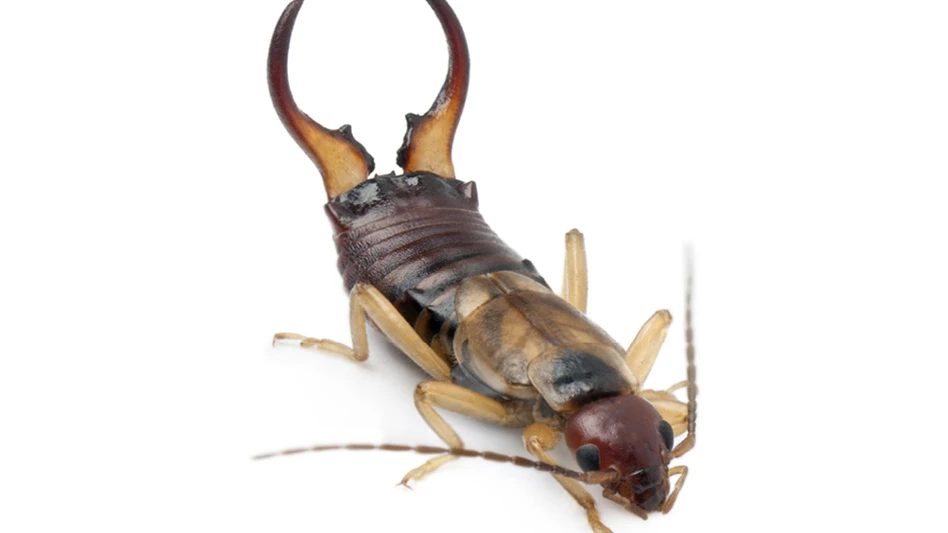

If earwigs had a better name and could lose those scary-looking “pincers” (cerci), they would no doubt have a better reputation. There are about 22 species of earwigs (order Dermaptera) in the United States; three are common pests with the European earwig, Forficula auricularia, being the primary invader in structures.
Earwigs range from 1/4 to 1 inch; the European earwig is 5/8-inch (16 mm) long, including cerci. These earwigs are glossy dark reddish-brown with lighter legs, 12-segmented antennae and somewhat flattened bodies. The well-developed cerci look like pincers and are used in defense and sometimes to capture prey. Males have curved cerci, while female cerci are almost straight.
Although European earwigs appear wingless, adults have membranous hind wings folded up under the short, front wing covers. They rarely fly. Immature earwigs are similar in appearance to adults. With each molt, the cerci and wings develop further. The wingless red-legged earwig and the striped earwig are common in southern and southwestern states.
Earwigs are unique in exhibiting maternal care. The female excavates a nest in an underground burrow, lays a clutch of eggs and then guards the eggs and the hatching young until they can fend for themselves. Earwigs are scavengers, feeding on plants and living or dead insects; they sometimes damage cultivated plants. They are attracted to lights and are active at night, hiding during the day in moist, shady places such as mulch or under stones or logs.

ROLE AS PESTS. Earwigs can accidentally find their way into structures in the same way as other occasional invaders, although European earwigs can climb trees and outside walls to also enter around roof lines. They reportedly like the moist shelter of shaker roofs. The European and red-legged earwigs sometimes invade homes in large numbers, especially during hot, dry spells. Earwigs also can be carried inside on items such as plants, newspapers or firewood. They give off a foul odor when crushed.
Since earwigs require high moisture, they do not survive long indoors, and insecticide control is usually not justified. Outside control involves removing harborage sites and drying out mulch and damp foundation areas. Pest-proofing around doors and windows is important. Insecticide baits and residual foundation treatments can be effective.
Technicians should remember that earwigs are outside insects that occasionally find their way indoors, usually in small numbers. Earwigs do not crawl into peoples’ ears nor bite. Larger species are reportedly capable of using their cerci to pinch if threatened.
The authors are well-known industry consultants and co-owners of Pinto & Associates.

Explore the July 2019 Issue
Check out more from this issue and find your next story to read.
Latest from Pest Control Technology
- Donny Oswalt Shares What Makes Termites a 'Tricky' Pest
- Study Finds Fecal Tests Can Reveal Active Termite Infestations
- Peachtree Pest Control Partners with Local Nonprofits to Fight Food Insecurity
- Allergy Technologies, PHA Expand ATAHC Complete Program to Protect 8,500 Homes
- Housecall Pro Hosts '25 Winter Summit Featuring Mike Rowe
- Advanced Education
- Spotted Lanternflies, BMSBs Most Problematic Invasive Pests, Poll Finds
- Ecolab Acquires Guardian Pest Solutions





